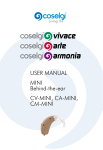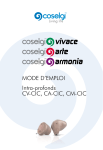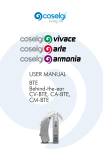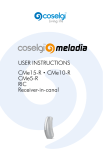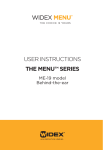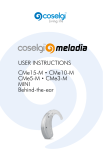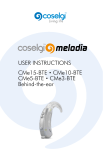Download USER MANUAL CIC Completely-in-canal CV-CIC, CA-CIC
Transcript
USER MANUAL CIC Completely-in-canal CV-CIC, CA-CIC, CM-CIC Your hearing aid (To be filled out by the hearing care professional) CV CA CM Date:_______________________________________ Battery size: 10 Short vent Full length vent 2 Contents Symbols . . . . . . . . . . . . . . . . . . . . . . . . . . . . . . . . . 4 Description of The hearing aid . . . . . . . . . . . . 5 The battery . . . . . . . . . . . . . . . . . . . . . . . . . . . . . . . . . 8 Inserting the battery . . . . . . . . . . . . . . . . . . . . . . . . . 8 Low battery indication . . . . . . . . . . . . . . . . . . . . . . 10 Turning the hearing aid on and off . . . . . . . . . . . . . . . 11 Right/left identification . . . . . . . . . . . . . . . . . . . . . . . 12 Positioning the hearing aid . . . . . . . . . . . . . . . . . . . . 13 Removing the hearing aid . . . . . . . . . . . . . . . . . . . . . 14 Volume adjustment . . . . . . . . . . . . . . . . . . . . . . . . . . 15 Cleaning . . . . . . . . . . . . . . . . . . . . . . . . . . . . . . . 16 The hearing aid . . . . . . . . . . . . . . . . . . . . . . . . . . . . 17 The sound outlet . . . . . . . . . . . . . . . . . . . . . . . . . . . . 19 The relief vent . . . . . . . . . . . . . . . . . . . . . . . . . . . . . . 20 The microphone opening . . . . . . . . . . . . . . . . . . . . . 21 wax guard . . . . . . . . . . . . . . . . . . . . . . . . . . . . . 22 Changing the wax guard . . . . . . . . . . . . . . . . . . . . . . 23 In case of malfunction . . . . . . . . . . . . . . . . . 26 Caring for your hearing aid . . . . . . . . . . . . . 28 Warnings . . . . . . . . . . . . . . . . . . . . . . . . . . . . . . 29 Advice . . . . . . . . . . . . . . . . . . . . . . . . . . . . . . . . . 32 REGULATORY INFORMATION . . . . . . . . . . . . . . . . 33 3 Symbols The following symbols will be used throughout the manual: WARNING Messages with this heading indicate serious adverse reactions, potential safety hazards and inadequate performance of device. CAUTION Messages with this heading indicate/include information regarding any special care to be exercised. Not for general waste. 4 Description of The hearing aid 1.Microphone opening 2.Battery drawer 3.Nail grip 4.On/off function 5.Sound outlet 6.Wax guard 7.Extraction cord 8.Relief vent (short) 9.Relief vent (full length) 5 WARNING This booklet contains important information and instructions. Please read this booklet carefully before you start using the hearing aid. NOTE Your hearing aid and accessories may not look exactly as illustrated in this booklet. We also reserve the right to make any changes considered necessary. 6 Intended use The hearing aids are intended as air conduction amplification devices to be used in everyday listening environments. Indications for use The devices are indicated for individuals with a range of hearing loss severity from minimal (0 dB HL) to moderately severe (75 dB HL) and all hearing loss configurations. They are to be programmed by licensed hearing care professionals (audiologists, hearing aid specialists, otolaryngologists) who are trained in hearing (re)habilitation. 7 The battery We recommend zinc-air batteries. Use a size 10 battery for the hearing aid. To obtain replacement batteries, please consult your hearing care professional. It is important to take note of the expiration date and the recommendations on the battery pack regarding disposal of used batteries. Otherwise there is a risk that the battery life may be reduced. Inserting the battery Before inserting a new battery into the hearing aid, remember to remove the adhesive tab. Once the tab has been removed, wait 60 seconds before placing the battery into the hearing aid. CAUTION Do not use batteries if there is a sticky residue from the tab or other unwanted substance, as this can cause the hearing aid to malfunction. 8 Use the nail grip to open the battery drawer. Do not press the battery drawer beyond the open position. Place the battery in the drawer so that the small plus (+) sign on the battery is visible when you hold the hearing aid as shown. You can use the battery magnet provided to steer the battery into place. If the battery drawer does not close easily, the battery is incorrectly inserted. When changing battery, it is a good idea to hold the hearing aid over a table. 9 Low battery indication Four rapid beep-tones will sound when the battery is nearly exhausted, unless this function has been disabled. We recommend that you always have a spare battery with you. For adjustment of the beep-tone level or disabling of the function, please consult your hearing care professional. WARNING Never leave an exhausted battery in the hearing aid. Exhausted batteries may leak, damaging the hearing aid. WARNING Your hearing aid may stop functioning, for instance if the battery is exhausted. You should be aware of this possibility, in particular when you are in traffic or are otherwise dependent on warning signals. 10 Turning the hearing aid on and off The battery drawer of the hearing aid also functions as the on/off switch. Close the battery drawer to turn on the hearing aid. Open the battery drawer to turn off the hearing aid. Please remember to turn off the hearing aid when it is not in use. Remove the battery if the hearing aid will not be used for several days. 11 Right/left identification Most models will be marked with a red logo or mark for the right ear and a blue logo or mark for the left ear. Another model has a red or a blue shell, respectively. 12 Positioning the hearing aid Close the battery drawer completely. Hold your hearing aid by the extraction cord with your thumb and forefinger. Slowly guide the hearing aid into your ear canal until you feel resistance. Let go of the extraction cord and use the tip of your forefinger to gently push the hearing aid into your ear until it rests comfortably in your canal. To help position the hearing aid properly you could pull the outer ear backwards and upwards with the opposite hand. 13 Removing the hearing aid Gently pull the extraction cord with your thumb and forefinger. If it is difficult, you can try to move the hearing aid carefully from side to side while pulling the extraction cord. It may also help to pull the outer ear backwards and upwards with the opposite hand. 14 Volume adjustment The hearing aid volume is adjusted automatically in accordance with your sound environment. CAUTION If the volume in the hearing aid is generally too loud or too weak, or the reproduced sounds are distorted, or if you would like any further information, consult your hearing care professional. 15 Cleaning The following cleaning accessories are available for cleaning the hearing aid. Ask your hearing care professional which accessories you need. 1.Brush 2.Cloth 3.Wax removing tool with a short and a long end 4.Long wax removing tool Contact your hearing care professional if you need additional supplies of cleaning accessories. 2. 1. 3. 4. 16 The hearing aid It is very important for the hearing aid’s performance that it is kept free from earwax and dirt. Clean your hearing aid daily with the soft cloth to keep it dry and clean of earwax or dirt. WARNING Never clean the hearing aid with water or cleaning solutions, as this may cause it to malfunction. When the hearing aid is not in use, the battery drawer should be left open, to ventilate the hearing aid and allow it to dry. We recommend that every time you take the hearing aid out of your ear, you inspect the sound outlet, the microphone opening in the battery drawer and the relief vent opening to ensure that no wax or dirt has gathered there. 17 Below is an example of how the sound outlet, relief vent and microphone opening may be positioned in a hearing aid provided with a short vent and a full length vent, respectively. 1.Sound outlet 2.Relief vent (short) 3.Microphone opening 1.Sound outlet 2.Relief vent (full length, outlet) 3.Relief vent (full length, inlet) 4.Microphone opening 18 The sound outlet It is important that the sound outlet is not blocked by earwax. Remove any visible earwax from around the sound outlet with the small brush or cloth. Do not attempt to clean the wax guard. If the sound outlet is blocked, you should change the wax guard (see pages 22-25). Warning If you cannot clean the sound outlet completely, you should contact your hearing care pofessional. Do not insert anything into the sound outlet, as this could damage the hearing aid. 19 The relief vent If earwax has accumulated in and/or around the relief vent opening, do as follows: Short vent: Clean any earwax from the vent as far as the long end of wax removing tool no. 3 can reach. Full length vent: Clean any earwax from the vent by passing the long wax removing tool (no. 4) all the way through the vent. Warning It is important for the performance of the hearing aid that the relief vent is never blocked. Make it a habit to clean the relief vent every day! In rare cases so much earwax can accumulate in the relief vent that the hearing aid sound is affected. In that case you should see your hearing care professional. 20 The microphone opening If dirt or earwax has gathered around the microphone opening on the hearing aid front, do as follows: Open the battery drawer and remove the battery. Turn the hearing aid so the open battery drawer is facing downwards. Guide the short end of wax removing tool no. 3 through the microphone opening on the battery drawer from the inside as illustrated. Warning If you suspect that earwax or dirt has migrated through the microphone opening and into the actual microphone inside the hearing aid, contact your hearing care professional. Do not insert anything into the actual microphone. 21 wax guard The wax guard helps to protect the hearing aid against earwax. Always use wax guards with your hearing aid. Otherwise the warranty for your hearing aid will be void. The wax guard consists of the following parts: 1.Holder 2.Removal hook 3.Wax guard Caution The wax guard is disposable and for one-time use only. Do not attempt to clean or reuse a wax guard. This could damage your hearing aid and/or cause the wax guard to become dislodged in your ear. 22 Changing the wax guard Insert the removal hook into the used wax guard placed in the sound outlet. Pull the wax guard straight out. 1.Vent opening 2.Sound outlet 3.Used wax guard 23 Turn the holder around so that the new wax guard is in position to be inserted. Insert the holder into the opening of the sound outlet and gently press the wax guard into the opening. Then pull the holder straight out. The new wax guard will automatically detach from the holder. Press the hearing aid gently against a flat surface to ensure that the wax guard remains in place. 24 Discard the holder with the used wax guard. The frequency with which the wax guard should be changed varies from one individual to another. If you have any questions regarding your wax guard, please contact your hearing care professional. Warning If the wax guard fits loosely, discard it and insert another. If the wax guard becomes dislodged from the hearing aid while in the ear canal, please contact your physician. Do not try to remove the wax guard from your ear canal yourself. 25 In case of malfunction Problem Possible cause Solution The hearing aid is completely silent The hearing aid is not turned on Make sure the battery drawer is closed The hearing aid volume is not powerful enough The hearing aid whistles continuously The battery does not Insert a new battery in work the hearing aid battery drawer The sound outlet is blocked See page 19 The microphone opening is blocked See page 21 The sound outlet is blocked See page 19 Your ear is blocked by earwax Contact your ENT doctor/physician Your hearing may have changed Contact your hearing care professional Your ear is blocked by earwax Contact your ENT doctor/physician The hearing aid is not correctly placed in your ear canal Take the hearing aid out and reinsert it The hearing aid fits loosely in your ear canal Contact your hearing care professional 26 Problem Possible cause Solution The hearing aid is uncom fortable to wear The hearing aid is not placed correctly in your ear canal Consult your hearing care professional on how to place the hearing aid correctly in your ear canal. The hearing aid Contact your hearing does not fit your ear care professional properly Your outer ear or ear canal is sore It is important that firsttime users only wear the hearing aid for short periods of time at the beginning. The skin in the ear canal is very thin and may swell a bit because of the pressure from the hearing aid. Take 2-3 weeks to gradually get used to the hearing aid. If the soreness continues, contact your hearing care professional If the problems persist, contact your hearing care professional for assistance. 27 Caring for your hearing aid The hearing aid is a valuable object and should be treated with care. Here are some things you can do to prolong the life of your hearing aid: CAUTION •Turn off your hearing aid when it is not in use. Remove the battery if the hearing aid will not be used for several days. •When the hearing aid is not in use, keep it in its case in a cool, dry location out of reach of children and pets. •Do not expose the hearing aid to extreme temperatures or high humidity. Make sure to dry the hearing aid thoroughly after heavy perspiration such as that which may occur during intense physical activity, e.g. playing sports. •Avoid dropping your hearing aid – perform cleaning and battery changes while holding the hearing aid above a soft surface. •Do not wear your hearing aid while in the shower or swimming, or when using a hair dryer, perfume, hair and body sprays or gels such as suntanning lotions or creams. •In environments with high humidity, a drying kit may be used daily to reduce the amount of moisture inside the hearing aid. See the instructions enclosed with the drying kit. 28 Warnings WARNING Hearing aids and batteries can be dangerous if swallowed or used improperly. Swallowing or improper use can result in s evere injury or even fatalities. In case of ingestion, contact a physician immediately and the 24 Hour National Button Battery Ingestion Hotline at (202) 625-3333. •Keep hearing aids and their parts, accessories and batteries out of reach of children and anyone else who might swallow such items or otherwise cause injury to themselves. Do not change batteries in front of them and do not let them see where you keep your battery supply. Discard used batteries carefully. •Batteries are very small and can easily be mistaken for pills or the like. Never put a battery or hearing aid in your mouth for any reason as you may risk swallowing it. 29 warning •Risk of explosion if battery is replaced by an incorrect type or recharged. Dispose of used batteries according to the instructions. •Never allow others to wear your hearing aid, as this could cause permanent damage to their hearing. •When selecting a listening program, please remember that there are situations in which it is particularly important to be able to hear the surrounding sounds (e.g. traffic, warning signals). •The hearing aid is made of modern non-allergenic materials. Nonetheless, in rare cases skin irritation may occur. If you notice skin irritation in or around your ear or ear canal, contact your hearing care professional. •Be aware that the use of any type of hearing aid may involve a slightly increased risk of infection in the ear canal. An infection can arise as a result of inadequate ventilation of the ear. We therefore recommend that you remove the hearing aid from your ear at night to allow the ear canal to be ventilated. Make sure that you clean and inspect your hearing aid as required. If an infection occurs, you should seek medical attention and contact your hearing care professional for advice on how to disinfect the hearing aid. Do not under any circumstances use alcohol, chlorine or similar substances. •Do not use Coselgi hearing aids in mines or other areas with explosive gases. 30 warning •Do not wear your hearing aid during radiation, X-rays, MRIs, CT or other medical treatments and scans. The emissions from these procedures as well as from other types of radiation, such as that in a microwave oven, can damage your hearing aid. R adiation from, for example, room surveillance equipment, burglar alarms and cell phones is weaker and will not damage the hearing aid, but may create audible interference. CAUTION •Although your hearing aid has been designed to comply with the most stringent international electromagnetic compatibility standards, the possibility cannot be excluded that it may cause interference with other equipment, such as medical devices. •Never try to open or repair the hearing aid yourself. 31 Advice NOTE •The hearing aid will not restore normal hearing and will not prevent or improve a hearing loss resulting from organic conditions. However, the hearing aid can help you to make the best possible use of your remaining hearing ability. You should also bear in mind that it can take time to get used to a new hearing aid and new sounds. •In most cases, using the hearing aid infrequently will not permit you to gain full benefit from it. •The use of a hearing aid is only part of hearing habilitation and may need to be supplemented by auditory training and instruction in lipreading. •The use of hearing aids increases the risk of accumulation of earwax. Contact your physician/ENT doctor if you suspect that a plug of earwax has accumulated in your ear. Earwax may not only reduce your own hearing but also the effect of the hearing aid considerably. It is a good idea to ask your physician to clean your ears a couple of times a year. 32 REGULATORY INFORMATION Contraindications: •Congenital or traumatic deformity of the ear •Active drainage from the ear within 90 days •History of rapid progressive hearing loss within previous 90 days •Acute or chronic dizziness •Sudden unilateral hearing loss in previous 90 days Important notice for prospective hearing aid users Good health practice requires that a person with a hearing loss have a medical evaluation by a licensed physician (preferably a physician who specializes in diseases of the ear) before purchasing a hearing aid. Licensed physicians who specialize in diseases of the ear are often referred to as otolaryngologists, otologists, or otorhinolaryngologists. The purpose of medical evaluation is to assure that all medically treatable conditions that may affect hearing are identified and treated before the hearing aid is purchased. Following the medical evaluation, the physician will give you a written statement that states that your hearing loss has been medically evaluated and that you may be considered a candidate for a hearing aid. The physician will refer you to an audiologist or a hearing aid dispenser, as appropriate, for a hearing aid evaluation. The audiologist or hearing aid dispenser will conduct a hearing aid evaluation to assess your ability to hear with and without a hearing aid. The hearing aid evaluation will enable the audiologist or dispenser to select and fit a hearing aid to your individual needs. If you have reservations about your ability to adapt to amplification, you should inquire about the availability of a trial-rental or purchase-option program. Many hearing aid dispensers now offer programs that permit you to wear a hearing aid for a period of 33 time for a nominal fee after which you may decide if you want to purchase the hearing aid. Federal law restricts the sale of hearing aids to those individuals who have obtained a medical evaluation from a licensed physician. Federal law permits a fully informed adult to sign a waiver statement declining the medical evaluation for religious or personal beliefs that preclude consultation with a physician. The exercise of such a waiver is not in your best health interest and its use is strongly discouraged. Children with hearing loss In addition to seeing a physician for a medical evaluation, a child with a hearing loss should be directed to an audiologist for evaluation and rehabilitation since hearing loss may cause problems in language development and the educational and social growth of a child. An audiologist is qualified by training and experience to assist in the evaluation and rehabilitation of a child with a hearing loss. 34 Hearing aids, accessories and batteries should not be disposed of with normal household waste. Please consult your national Coselgi distributor for advice on how to dispose of these items. 35 Manufacturer ¡9 514 0201 041j¤ ¡#01v¤ Printed by HTO / 2013-09 9 514 0138 041 #02




































